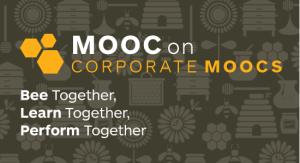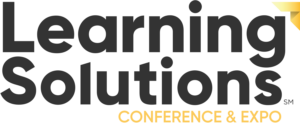 The second week of Intrepid Learning’s MOOC on Corporate MOOCs is now complete. This post reflects on my experience in the MOOC, looking at my experience from two separate angles: That of a learner and that as a learning and performance professional. I will start by commenting on the content of the MOOC, and then reflect on the way the learning experience was constructed.
The second week of Intrepid Learning’s MOOC on Corporate MOOCs is now complete. This post reflects on my experience in the MOOC, looking at my experience from two separate angles: That of a learner and that as a learning and performance professional. I will start by commenting on the content of the MOOC, and then reflect on the way the learning experience was constructed.
What Did We Learn?
Week two of the MOOC on Corporate MOOCs took a deeper dive into the world of corporate MOOCs. The week had fewer modules – 4 this week as compared to 6 last week – but no shortage of great content.
The first module set the stage for week 2 of the MOOC while revisiting and expanding upon the content of week 1. I liked this module a great deal. I always value reflection as part of learning; it’s one of the reasons I like to write posts like this. Week 2 kicked off with some learning moments from week 1. I especially liked the curated posts from various discussions that pulled out key learning points and put the content from week 1 into context. It was a great way to set the stage for week 2. I also appreciated that this module reflecting the evolving nature of the course, as the syllabus was updated based upon the interests that were expressed by participants during the week.
The next module explored what makes a MOOC engaging for a learner. We explored various ways to keep people engaged, including some great examples from the world of marketing. The course then moved on to a discussion of cohorts, and how they can be leveraged to enhance the MOOC experience. The module ended with great information on the value of providing bite-sized content and how gamification and badges can increase engagement and participation.
 Next was a re-positioning of the question posed in the previous module, as this module explores what makes a MOOC great for an organization. We explored the four “I” metrics that can be used to measure the effectiveness of an organizational MOOC – Involvement, Interaction, Intimacy, and Influence. There was plenty of discussion around how these metrics can provide real value to an organization. The module also covered the credentials that could be attached to MOOCs and one of the main benefits of MOOCs in a corporate setting: scalability.
Next was a re-positioning of the question posed in the previous module, as this module explores what makes a MOOC great for an organization. We explored the four “I” metrics that can be used to measure the effectiveness of an organizational MOOC – Involvement, Interaction, Intimacy, and Influence. There was plenty of discussion around how these metrics can provide real value to an organization. The module also covered the credentials that could be attached to MOOCs and one of the main benefits of MOOCs in a corporate setting: scalability.
The last module provided a nice conclusion to the week, exploring how to decide if a MOOC is the right fit for your organizational learning and performance need. A simple but powerful job aid was provided that had 12 questions organizations should be asking themselves before they go down the MOOC road. Each of the questions was explored to give context, so that participants could take the job aid and effectively apply it in their organizations. It was a great way to tie together the content of the week in an actionable way.
The MOOC Experience
Putting on my Learning and Performance Professional hat, there was a lot I liked about this week. The first thing I noticed was the open and agile way the MOOC seems to be being run behind-the-scenes. In the opening module there was an acknowledgement that the organizers of the event learned from week 1 as well. They saw the aspects of the content that were important to participants and adjusted the course curriculum accordingly. There was also discussion related to the participant suggestion to include Open Office Hours with the moderators. The course also has a certain agility attached to it, as evidenced by the inclusion of current events like the recent announcement of Starbucks partnership with Arizona State University.
This was all done openly and publicly, in a way that was integrated into the content. In an environment where learning content is too often top-down and hierarchy-based, it’s refreshing to see the management of learning content handled in an openly collaborative fashion.
I also liked the way the MOOC was managing the social aspect of the course. There was active moderation of the discussion boards, where conversation and sharing was encouraged. There was also curation of the discussions. Pulling out key contextual learning points from the discussion boards and integrating them into the formal learning path of the course gives them much greater visibility.
 Lastly, I am enjoying watching the balance between creation and curation take shape. There is a great deal of content being shared within the MOOC. Some of it was created by Intrepid Learning, some of it was curated by the MOOC designers and brought into the course. In some cases the curated content is part of what I perceive as the “critical learning path” of the experience, and in some cases the curated content is there to expand upon the content for learners that want to dig deeper into a particular topic. I find curation to be a huge part of the future of workplace learning, so it’s been very interesting to see it put into action during this MOOC.
Lastly, I am enjoying watching the balance between creation and curation take shape. There is a great deal of content being shared within the MOOC. Some of it was created by Intrepid Learning, some of it was curated by the MOOC designers and brought into the course. In some cases the curated content is part of what I perceive as the “critical learning path” of the experience, and in some cases the curated content is there to expand upon the content for learners that want to dig deeper into a particular topic. I find curation to be a huge part of the future of workplace learning, so it’s been very interesting to see it put into action during this MOOC.
Exploring Participation and Completion
There are so many variables that impact a learning experience, be it a MOOC or something else. As learning professionals, we often battle the need to provide support and learning to employees against the needs of work. Any formal learning experience is likely going to involve some level of interruption to the actual performance of work – You likely can’t be “in training” and “doing your job” at the same time.
I lived that challenge this week, and it altered my experience as a learner. I was hosting and speaking at the mLearn Conference and Expo last week, which takes up a huge amount of my attention. When I’m working at a conference, my days are packed from early morning till the evening. When I get back to my hotel at the end of the day, there’s usually more work to be done. As such, I didn’t have much time to dive into the MOOC until the weekend.
It changed the experience a bit for me. Instead of actively participating in discussions, I was passively reading discussions that had taken place. In addition, the MOOC on Corporate MOOCs falls under the heading of “optional learning” for me. It’s important, but there’s no real accountability attached to completion of the MOOC other than my own personal desire. It left me thinking how I would manage a similar scenario for a learner in a corporate MOOC I was running that *did* have a completion requirement.
These subtle shifts in the ways we perceive and define participation and completion are interesting. It will be interesting to see how they evolve as more organizations adapt the MOOC format as part of their strategies.
The Last Week… or is it?
We’re already entering the final week of the MOOC on Corporate MOOCs. I’m looking forward to capping the course off with a discussion of getting started with Corporate MOOCs, including how to make the case for a MOOC, and how to effectively design and develop the MOOC experience. I’m also interested in continuing to explore this topic after the formal time of the “course” ends. There were a number of great resources shared during the first two weeks, some of which I didn’t have the opportunity to explore as deeply as I might have liked, and others that I’d like to revisit.
And for me, that’s the sign of a great learning experience.
Until next week, I’ll see you on the discussion boards.







